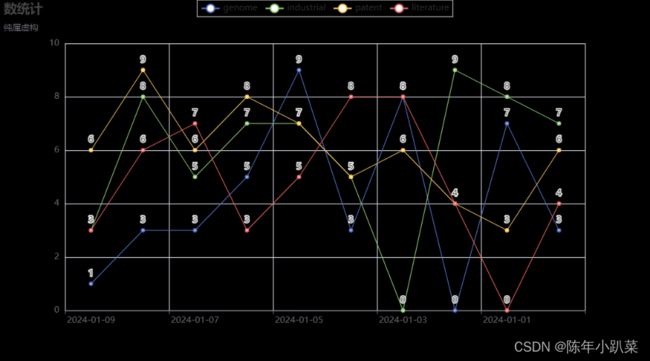Python基础(二十四、JSON和pyecharts)
文章目录
- 一、JSON
-
- 1.JSON介绍
- 2.JSON格式数据转化
- 3.示例
- 二、pyecharts
-
- 1.安装pyecharts包
- 2.查看官方示例
- 三、开发示例
一、JSON
1.JSON介绍
JSON是一种轻量级的数据交互格式,采用完全独立于编程语言的文本格式来存储和表示数据(就是字符串)。
Python语言使用JSON有很大优势,因为JSON无非就是一个单独的字典或一个内部元素都是字典的列表。
总结所以JSON可以直接和Python的字典或列表进行无缝转换。
2.JSON格式数据转化
通过 json.dumps(data) 方法把python数据转化为了json数据
data = json.dumps(data)
如果有中文可以带上:ensure ascii=False参数来确保中文正常转换
通过 json.loads(data) 方法把json数据转化为了 python列表或字典
data = json.loads(data)
3.示例
echarts/
__init__.py
data.txt
jsonData.py
data.txt
{
"code": 10000,
"msg": null,
"error": true,
"data": {
"total": 1664,
"items": [
{
"stat_date": "2024-01-09",
"genome": 1,
"industrial": 3,
"literature": 3,
"patent": 6
},
{
"stat_date": "2024-01-08",
"genome": 3,
"industrial": 8,
"literature": 6,
"patent": 9
},
{
"stat_date": "2024-01-07",
"genome": 3,
"industrial": 5,
"literature": 7,
"patent": 6
},
{
"stat_date": "2024-01-06",
"genome": 5,
"industrial": 7,
"literature": 3,
"patent": 8
},
{
"stat_date": "2024-01-05",
"genome": 9,
"industrial": 7,
"literature": 5,
"patent": 7
},
{
"stat_date": "2024-01-04",
"genome": 3,
"industrial": 5,
"literature": 8,
"patent": 5
},
{
"stat_date": "2024-01-03",
"genome": 8,
"industrial": 0,
"literature": 8,
"patent": 6
},
{
"stat_date": "2024-01-02",
"genome": 0,
"industrial": 9,
"literature": 4,
"patent": 4
},
{
"stat_date": "2024-01-01",
"genome": 7,
"industrial": 8,
"literature": 0,
"patent": 3
},
{
"stat_date": "2024-01-10",
"genome": 3,
"industrial": 7,
"literature": 4,
"patent": 6
}
],
"has_more": true
}
}
jsonData.py
import json
def formatData():
# 日期列表
date_data = {}
date = []
# 数据
genome_data = []
industrial_data = []
literature_data = []
patent_data = []
try:
with open("D:/test/demo/echarts/data.txt","r",encoding="utf-8") as file:
for line in file:
line = line.strip()
if len(line.split(":")) == 1:
continue
data = line.split(":")[1].replace('"',"").strip(" ,")
if line.startswith('"stat_date"'):
date.append(data)
elif line.startswith('"genome"'):
genome_data.append(data)
elif line.startswith('"industrial"'):
industrial_data.append(data)
elif line.startswith('"literature"'):
literature_data.append(data)
elif line.startswith('"patent"'):
patent_data.append(data)
except Exception as e:
print(f"出现异常啦:{e}")
date_data["date"] = date
date_json = json.dumps(date_data)
genome_json = json.dumps(genome_data)
industrial_json = json.dumps(industrial_data)
literature_json = json.dumps(literature_data)
patent_json = json.dumps(patent_data)
print(f"{type(date_json)},{date_json}")
print(f"{type(genome_json)},{genome_json}")
print(f"{type(industrial_json)},{industrial_json}")
print(f"{type(literature_json)},{literature_json}")
print(f"{type(patent_json)},{patent_json}")
return date_json,genome_json,industrial_json,literature_json,patent_json
输出:
,{"date": ["2024-01-09", "2024-01-09", "2024-01-09", "2024-01-09", "2024-01-09", "2024-01-09", "2024-01-09", "2024-01-09", "2024-01-09", "2024-01-09"]}
,["1", "3", "3", "5", "9", "3", "8", "0", "7", "3"]
,["3", "8", "5", "7", "7", "5", "0", "9", "8", "7"]
,["3", "6", "7", "3", "5", "8", "8", "4", "0", "4"]
,["6", "9", "6", "8", "7", "5", "6", "4", "3", "6"]
二、pyecharts
开发可视化图表使用的技术栈是Echarts框架的python版本:pyecharts包。
1.安装pyecharts包
通过pip下载pyecharts包,在开发过程中直接引用即可。
下载命令如下:
pip install pyecharts
代码中引用示例:
import pyecharts.options as opts
from pyecharts.charts import Line
2.查看官方示例
pyecharts-gallery,可通过官方示例详细学习和使用。
三、开发示例
下面我们就是用上面的JSON和pyecharts进行实践,生成一个折线图,且带有工具栏。通过浏览器访问html文件可查看统计图。例如:

可通过工具栏中下载图片,切换柱状图,折线图,数据等。
代码示例如下:
echarts/
__init__.py
data.txt
jsonData.py
# 运行后生成line.html
line.html
line.py
jsonData.py代码不变
line.py
import json
import pyecharts.options as opts
from pyecharts.charts import Line
import jsonData
date_json,genome_json,industrial_json,literature_json,patent_json = jsonData.formatData()
date = json.loads(date_json)["date"]
(
Line()
.add_xaxis(xaxis_data=date)
.add_yaxis(
series_name="genome",
y_axis=json.loads(genome_json),
symbol="emptyCircle",
is_symbol_show=True,
label_opts=opts.LabelOpts(is_show=True)
)
.add_yaxis(
series_name="industrial",
y_axis=json.loads(industrial_json),
symbol="emptyCircle",
is_symbol_show=True,
label_opts=opts.LabelOpts(is_show=True)
)
.add_yaxis(
series_name="patent",
y_axis=json.loads(patent_json),
symbol="emptyCircle",
is_symbol_show=True,
label_opts=opts.LabelOpts(is_show=True)
)
.add_yaxis(
series_name="literature",
y_axis=json.loads(literature_json),
symbol="emptyCircle",
is_symbol_show=True,
label_opts=opts.LabelOpts(is_show=True)
)
.set_global_opts(
title_opts=opts.TitleOpts(title="数统计", subtitle="纯属虚构"),
tooltip_opts=opts.TooltipOpts(trigger="axis"),
toolbox_opts=opts.ToolboxOpts(is_show=True),
xaxis_opts=opts.AxisOpts(type_="category"),
yaxis_opts=opts.AxisOpts(
type_="value",
splitline_opts=opts.SplitLineOpts(is_show=True),
)
)
.render("D:/test/demo/echarts/line.html")
)

